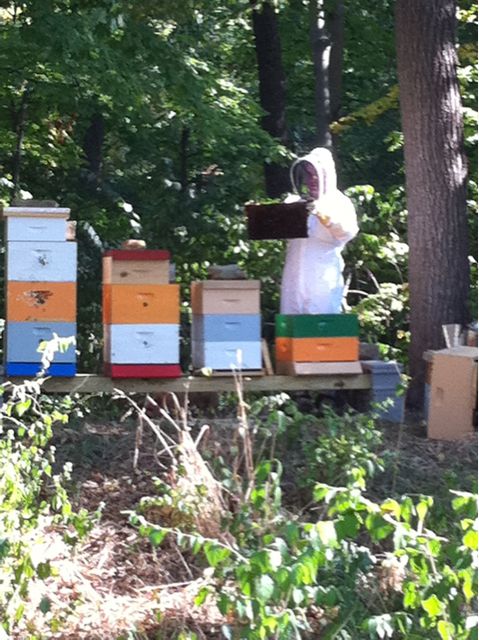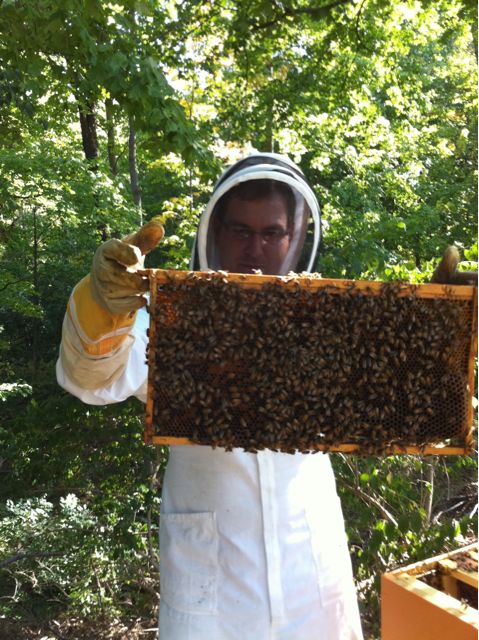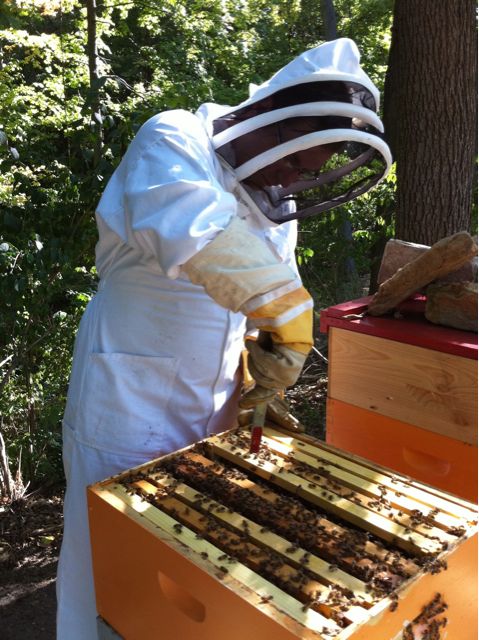A Space Is Prepared, and the Bees Fill It
We spent much of the weekend on our farm in Waco, Kentucky. Now that Deb owns the farm outright, we feel we can begin making a few slight changes in the way things work down there. For instance, I think we’re gonna ask all the relatives to come and get whatever they want from the old farmhouse and the shed and the barn; whatever’s left that we don’t want will go up in flames in a bonfire the likes of which Madison County hasn’t seen in a long long time. Keep your eyes on the sky the day following Labor Day.
Why clear all that stuff from the house, the shed, the barn? Sometimes you just need to make some room. Creativity requires room. How can new things come to you, Reader, if there’s no space in which to hold it?
So, Brent (the guy who leases the farm to run some cattle) has recently changed his life. He’s made room in it for new things, and he’s ready to keep bees. We’re thinking of starting about 10 hives down there next spring. The farm is a 2-hour drive from here, and because we get down there only about once a month, it’s important to have someone keeping an eye on the bees…and Brent seems perfectly delighted at that prospect. He’s decided on a spot against a fence for the hives. He’s planning to seed a field in clover. For whatever reason, a reason I have no need to understand, Brent needs bees. Just as I did.
You know, Reader, I find it quite fascinating that some people—people such as Brent and me (and perhaps even you)—become ready. I don’t know how to describe it, but I can spot it right away. A light appears in the eye. A space is held open in the body for it. Other people make polite conversation, but those who are ready cannot be satisfied with small talk. Might as well go ahead and buy those people a smoker of their own.
A Smoker Sets the Tone
You should smell my car. Well, first you should know that I drive a 12-year old Nissan Pathfinder (it has over 160K miles on it, but I’m not giving it up…I figure I can get 250K miles out of it. I don’t quit on things).
My car smells like smoke and beeswax, and it’s a joy to sit in when I’ve been visiting beeyards. Why? Because the smoker’s still smoldering in the car, and I often have some freshly used frames of beeswax in there with me.
So, let’s talk about the smoker—which is the single most important tool when it comes to keeping bees. Even those beekeepers who don’t routinely wear veils use smoke. I’ve never met a beekeeper who doesn’t have a smoker lit and ready to use when visiting the bees, and I probably wouldn’t work with one who didn’t.
And wouldn’t you know it? The single most important beekeeping tool is also one of the most pleasant and sensory to use…but it’s also (initially) a pain in the neck. It takes some time and some attention (and some experience) to get a smoker properly puffing away…and I admit, it’s tough to carve out the necessary time and attention when you’re in a rush to open a hive. Frankly, I’ve come to think of lighting the smoker and nurturing the smoke from it as a sensory way to transition from the rush rush rush of daily life to the calmer behaviors appreciated by the bees.
You want to know why beekeepers use smokers, don’t you, Reader? Well, the short of it is this: Beekeepers announce their arrival at the hive by puffing a bit of smoke into the hive entrance and under the lid. This announcement leads the bees to think there may be fire in the area, so they begin the process of engorging with honey in the event they must leave to find a new place to live. And when bees eat honey, they become calm. A bee filled with honey does not want to sting. However, in the event a bee didn’t get the message and does sting, the smoke serves to mask the alarm pheromone (emitted at the time of the sting) that signals other bees of danger; so, it reduces the chances of more stings.
We keep the smoker lit and puffing away in the event the bees become agitated. A little cloud of cool smoke settles everyone down…including the beekeeper who, when she operates those billows, feels as if she may have some sort of control over the world. Which she does not have at all. But it smells nice and looks cool.
All of this to say that I’m now using a new smoker—a Rauchboy. From Germany. It looks awesome and smolders like crazy. It’s a little more expensive than the run-of-the-mill smokers, but I want mine to stand out in a crowd. I’ve kept it lit in the backyard just for the heck of it…just so it can hurry up and get its patina on.

Bad to the Bone
My new top-bar hive is being met with general displeasure. The plywood doesn’t seem to be aesthetically pleasing to too many people. I like it. I’d prefer to use some rough-cut lumber, I guess, but that’s not easy to find, Reader. Others want me to see my next hive made of pine.
I think my aesthetics are just different from most.
I LOVE the corrugated tin roof, but it presented a safety issue. No one would go near its shredded edges. The words “to the bone” were often heard. So, on Friday, my friend Sherry and I headed to Loesch Hardware store (where those guys can figure anything out), and we bought some trim stuff and some silicone calk. We trimmed the aluminum shards from the cut edges; we bent the corners down; we lined the edges with this rubber trim stuff and calked it in silicone. Now it’s safe, and I still like it. (Once the sun comes up, I’ll take a picture of it and post it for you.)
Next time, though, I’m going to a metal fabricator to have my tin cut.
.
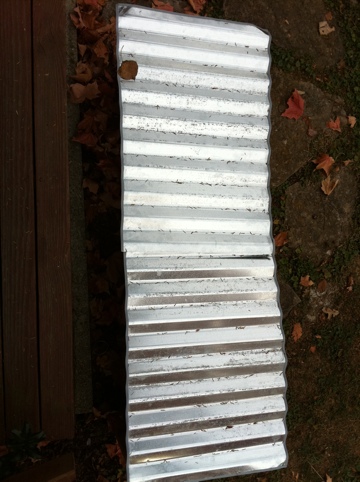

My First Top-Bar Hive
I know you want to see my first Kenya Top-Bar Hive.
I’ve already got plans for a wider, shorter one…one that will accept the frames from my medium-depth Langstroth hive boxes. I want the flexibility of swapping frames from any hives in my yard.
I learned, though, from Michael Bush (I think of Michael Bush as I the Walter Cronkite of beekeeping: the most trusted name in bees) on Beemaster.com., that the waxed-string guides aren’t much of a guide. So, on my next hive, I’ll use something else I have up my sleeve. Shit. I thought I had the perfect solution to a simple guide. I think I’ll leave the waxed string on this hive, though, and see for myself how the bees deal with it.
Also: I love the look and the function of the corrugated tin roof, but cutting it is a bitch. And I’m sure to get little slivers of tin in my hands whenever I inspect the hive. Either slivers or stitches. I gotta find a metal smith to help me cut it better.
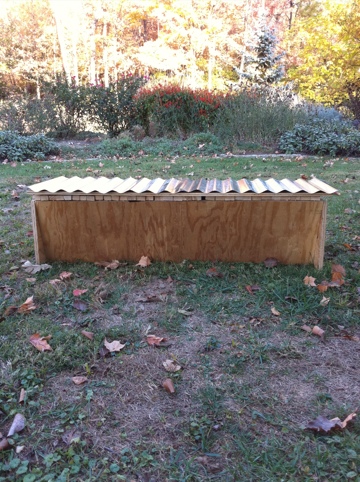
.
If You're Drinking Up, Please Send Your Corks My Way
It’s turned cold these past few days. By “cold,” I mean the low temperatures are in the high 30s or low 40s and the highs are in the 50s. We haven’t yet turned on the heat, but we are sleeping with the electric blanket on low.
And a few of my hives have those augur holes drilled in them. Which means I need to plug those holes so the bees can more easily regulate the temperature in there. This hole-drilling practice was something I saw done by Chris, the guy who started me beekeeping…so I did it too. I thought it was a great idea to give the bees some more air. Maybe because I like to have a lot of fresh air myself. Funny how we project our need on others, isn’t it?
But I’ve since learned that the bees don’t need me to give them air. They do better when they regulate the temperature and moisture in their own homes. It’s as if someone were to come into your home and open or close all the windows or fiddle with your thermostat. That’s just rude…and then I’d have to go around spending unnecessary time and energy readjusting your decision for me.
Anyway…it’s cold, and those augur holes need to be plugged. I want to use corks from wine bottles because they’re made from natural material. But I don’t drink alcohol, so it’s tough coming up with corks. Last year I plugged the holes with pine cones. So, if you’re sitting around drinking bottle after bottle of wine, please forward your corks my way. I need about 6 or 8 of them.
I Should've Worn a Hat
I went out to the beehives at 3:15 PM yesterday in order to film for you the young Amazon bees orienting. They were so active that I wanted you to see them, too, Reader. I got a brief video of them, but then a bee went in my ear and freaked me out. I slapped and slapped to get it out.
Then I heard more bees. In my hair. By this time I was running through the yard slapping. And getting stung. (Yes, Reader, I am well aware that this slapping and freaking out doesn’t help the situation. I’m not stupid.) I picked up an old sweatshirt laying in the yard and began slapping my head with that. I got stung about 6 times—in my head and ear and neck.
Once the stinging stopped, I realized that all this slapping had flung my glasses off my face. Probably deep into the woods. Deb and I have searched and searched and we can’t find them. We even went out there at night to see if the beam from a flashlight would reflect off them. No.
I am now wearing very very old glasses. I look odd, and I can’t read.
But here’s your damn video. (Once again, I forgot to turn the camera sideways for the wider view. I don’t know why I can’t remember to do that. Sorry.)
http://www.youtube.com/watch?v=i0l4G4gVlU0
From "Colony" to "Swarm" to "Colony"
I don’t love the telephone. However, these past few months I get a lot of calls about bees, and I like those calls a lot. Why? I don’t know…maybe because I’m never sure what situation will present itself, and that’s fun. These past couple of weeks, I’ll bet I get 2 or 3 calls each week about “swarms of bees” somewhere. A couple of months ago, this number was higher.
But what the callers usually describe are not swarms of bees. You see, Reader, a swarm is a very specific term used for bees in the midst of migrating from one home to another. Before they swarm, they’re part of a colony of bees. When they leave that colony and set up a new home, they’ll once again be a colony of bees. While they’re between the two—while migrating—they’re considered a swarm. They move from “colony” to “swarm” to “colony.”
A swarm is usually spotted hanging in a big, droopy, living, breathing blob on a tree branch or a light post or some other structure on which it’s easy to hang together. The swarm waits there for about 12-48 hours until the scout bees decide on a new home; once the new home is found…poof!…the swarm is gone in a blink of an eye. While it hangs there, however, a swarm of bees seems both awesome and scary (I call it “sublime”), so people call a beekeeper about it.
There’s a swarm season, Reader. Bees in Ohio usually swarm during our spring months…April through June.
I’ve discovered that people who call me about “a swarm” (when we’re not in swarm season) really mean to report “a lot of bees swarming around” their roofline or their doorframe or their soffit; the bees have been “swarming” for a while, and the caller is worried. Well, Reader, this is not a swarm…remember, a swarm doesn’t yet have a home of its own. The good news is this: The bees these callers call about already have a nice home. The bad news for the caller is this: The bees’ home is also the caller’s home.
This post is getting too long, so I’ll finish it tomorrow.
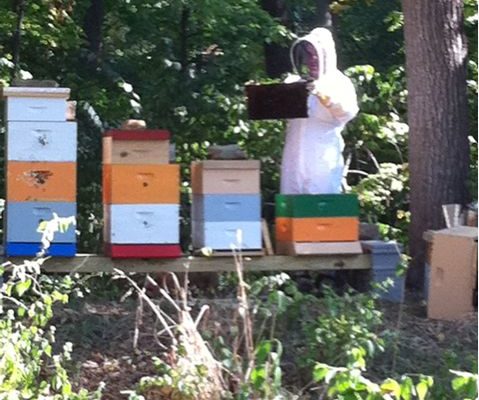
Jerod Visits the Bees
Jerod is the first person other than me to work in my hives. He’s also the first person to visit the bees who wants to keep a hive himself…and I trust the way Jerod works, so there you go. In anticipation of getting his first hives next spring, he’s been reading The Complete Idiot’s Guide to Beekeeping, and he wanted to see into a living hive so he could identify what he’s reading about.
So, he suited up, lit the smoker, kept the smoker smoking, smoked the hives, lifted the lids, removed the frames, and inspected the bees. I didn’t touch a thing. (He also helped me rake a mound of sugar from under each of the hives…I can’t tell if the sugar is slipping out of each hive or if the bees are removing it intentionally, but the yellow jackets were going bonkers in it. Damn yellow jackets).
Before we began, I asked Jerod what he was looking forward to as he got his first glimpse into a bee hive. He said he was curious to know what it feels like to be stung, and he was curious to see if he got a little squirrely when he saw that many bees in one place. I’m here to report that although Cricket, Jerod’s dog, was stung, Jerod was not. And Jerod was as calm and soothing as could be with the bees. And the bees responded by being mellow beyond belief.
We saw bees coming in loaded with pollen, we saw drones, we saw bees eating, we saw bees festooning. We saw bee bread and capped honey and capped brood, and we saw a bee get her first glimpse of the world…she was just poking her head from her capped cell. Very cool…she seemed all eyes.
It was nice to be able to take a few pictures for you, Reader…it’s not easy to handle a camera and the hive tool and the frames of bees all at once. And those gloves don’t make it any less of a challenge.
Jerod and I are now talking about building our top-bar hives this winter.
The Good News
Here’s the good news as promised, Reader. The bad news, as you’ll recall, is that the bees from the tree have now been combined with the Girls of Summer, and the small swarm I collected last week absconded.
But on Sunday’s inspection of the remaining four hives, I found two absolutely gorgeous queens at work. The queen in Tomboys was moving around on comb the bees had drawn on their foundationless frames. It was beautiful to see. And the queen in Girls of Summer is HUGE. I was spellbound watching her (also moving about on comb drawn on foundationless frames). I don’t know why it’s so uplifting to spot the queen and then to see how healthy she looks and how calm she is and how wonderful the hive is doing. But, I was uplifted.
Another thing that really surprised me was the health of the split hive. In July I took a frame containing one or two queen cells from Tomboys; from other hives I added two frames of brood and a frame full of honey, and I started a new hive. And though they haven’t drawn new comb since then, they’ve certainly filled the frames with which they began, and those frames were covered with bees. The colony seemed calm and relaxed and healthy.
I’ve decided to move the split hive into a 5-frame nuc for the winter, though. There’s too much empty space around the filled frames (they’re currently living on 4 deep frames hung in a stack of 2 medium boxes), and that’ll be hard to heat in the winter.
One thing I’m learning about beekeeping…timing is everything. Seriously…that “To everything there is a season” thing from the Bible makes more and more sense as I get older.

